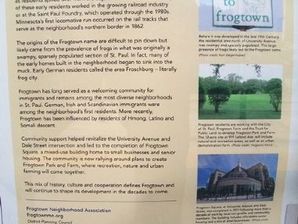Welcome to Dale Street Station
The Frogtown neighborhood developed in the late 19th Century as residents spilled over from the adjacent downtown area. Many of these early residents worked in the growing railroad industry or at the Saint Paul Foundry, which operated through the 1980s. Minnesota's first locomotive run occurred on the rail tracks that served as the neighborhood's northern border in 1862.
The origins of the Frogtown name are difficult to pin down, but likely came from the prevalence of frogs in what was originally a swampy, sparsely populated section of St. Paul. In fact, many of the early homes built in the neighborhood began to sink into the muck. Early German residents called the area Froschburg - literally frog city.
Frogtown has long served as a welcoming community for immigrants and remains among the most diverse neighborhoods in St. Paul. German, Irish, and Scandinavian immigrants were among the neighborhood's first residents. More recently, Frogtown has been influenced by residents of Hmong, Latino and Somali descent.
Community support helped revitalize the University Avenue and Dale Street intersection and led to the completion of Frogtown Square, a mixed-use building home to small businesses and senior housing. The community is now rallying around plans to create Frogtown Park and Farm, where recreation, nature and urban farming will come together.
This mix of history, culture and cooperation defines Frogtown and will continue to shape its development in the decades to come.
[Photo caption, from top to bottom, read]
Before it was developed in the late 19th Century, the residential area north of University Avenue was swampy and sparsely populated. The large presence of frogs likely led to the Frogtown name.
———————
Frogtown residents are working with the City of St. Paul, Frogtown Farm and the Trust for Public Lands to develop Frogtown Park and Farm. The 12-acre site at 919 Lafond Ave will include natural and recreation areas, as well as an urban demonstration farm.
———————
Frogtown Square, at University Avenue and Dale Street, was completed in 2011 following more than a decade of work by local non-profits and community members. The building includes affordable senior housing and mix of small businesses.


